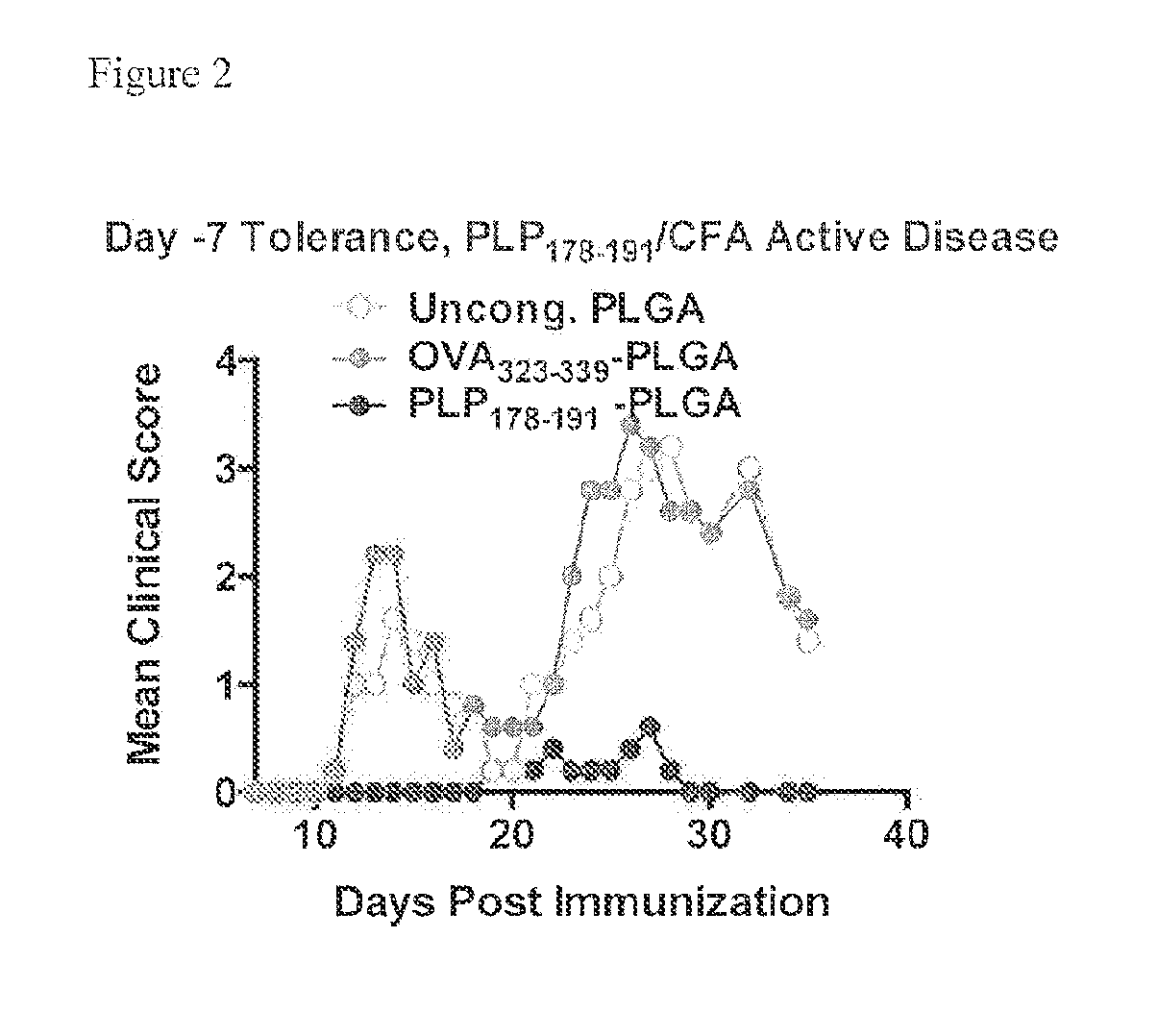Peptide conjugated particles
a technology of conjugated particles and peptides, applied in the field of peptide conjugated particles, can solve the problems of high cost of process, high cost, and high risk of severe side effects of life-long immunosuppressive drug therapy
- Summary
- Abstract
- Description
- Claims
- Application Information
AI Technical Summary
Benefits of technology
Problems solved by technology
Method used
Image
Examples
example 1
Preparation of Negatively Charged Immune Modifying Particles (IMPs)
[0199]To a solution of Poly(ethylene-maleic anhydride) (PEMA) in D2O (4 mL, 1% w / v) was added dropwise a solution of poly(lactide-co-glycolic acid) (PLG) in dichloromethane (DCM) (2 mL, 20% w / v). The mixture was allowed to sonicate on ice at 16 watts for 30 sec using the VC 30 Ultrasonic Processor. The resulting homogenized crude was then poured into a solution of D2O (200 mL containing 0.5% w / v of PEMA). The homogenized slurry was allowed to stir overnight at speed setting of 3.5 using Bellco Glass, Inc., Bellstir Multi-stir 9 magnetic stirrer (10 W for 10 s, 16 W for 10 s, 16 W for 30 s).
Results
[0200]After three hours of stirring, particle size analyses were performed using dynamic light scattering in disposable polystyrene cuvettes
[0201]a. 10 W, 10 s−Z-average=499.9 nm−PdI=0.23, Peak=634.5 nm
[0202]b. 16 W, 10 s−Z-average=528.9 nm−PdI=0.227, Peak=657.5 nm
[0203]c. 16 W, 30 s−Z-average=471.6 nm−PdI=0.228, Peak=580.5 ...
example 2
Administration of Antigen-Coupled PLGA Beads Prevents Relapsing Experimental Autoimmune Encephalitis
[0214]PLG nanoparticles were investigated with the immunodominant proteolipid protein PLP139-151 epitope (PLG-PLP139-151) to induce tolerance for prevention of Relapsing Experimental Autoimmune Encephalitis (R-EAE). The R-EAE mice were generated as described above.
[0215]The peptides administered to the animals were coupled to particles with the mean diameter of 500 nm. Mice were treated with either PLP139-151-PLGA (N=5), OVA323-339-PLGA (N=5), or uncongugated PLGA (N=5) on day −7 relative to the time of immunization (day 0). Peak disease was typically observed around day 12 to 14, and mice are scored for clinical disease. Particles without peptide, or modified with the control peptide OVA323-339 did not prevent disease induction. However, PLGA particles modified with PLP139-151 produced a clinical score of 0 (no disease) at all except low clinical scores of under 1 exhibited between d...
example 3
Intravenous Infusion of Antigen Coupled PLG Particles does not Induce Anaphylaxis-Induced Temperature Drop in OVA / Alum Pre-Sensitized Animals
[0218]Due to the presence of active disease, anaphylaxis to the antigens is a concern, which could result in immediate mortality, and has been described with polystyrene bound particles. Anaphylaxis is associated with a significant drop in body temperature. To test whether intravenous administration of OVA-PLG induces an anaphylaxis-induced temperature drop in pre-sensitized animals, mice were immunized at day 0 with 10 μg OVA / Alum via intraperitoneal injection. On day 14, the mice were again immunized with 10 μg OVA / Alum via intraperitoneal injection, and then tolerized with OVA-PLG administered intravenously on day 21. On day 28, the mice were then tolerized with either OVA-PLG particles or OVA via intravenous administration.
[0219]As shown in FIG. 4 those mice treated with soluble OVA on day 28 exhibited decrease in temperature compared with ...
PUM
| Property | Measurement | Unit |
|---|---|---|
| diameter | aaaaa | aaaaa |
| diameter | aaaaa | aaaaa |
| diameter | aaaaa | aaaaa |
Abstract
Description
Claims
Application Information
 Login to View More
Login to View More - R&D
- Intellectual Property
- Life Sciences
- Materials
- Tech Scout
- Unparalleled Data Quality
- Higher Quality Content
- 60% Fewer Hallucinations
Browse by: Latest US Patents, China's latest patents, Technical Efficacy Thesaurus, Application Domain, Technology Topic, Popular Technical Reports.
© 2025 PatSnap. All rights reserved.Legal|Privacy policy|Modern Slavery Act Transparency Statement|Sitemap|About US| Contact US: help@patsnap.com



